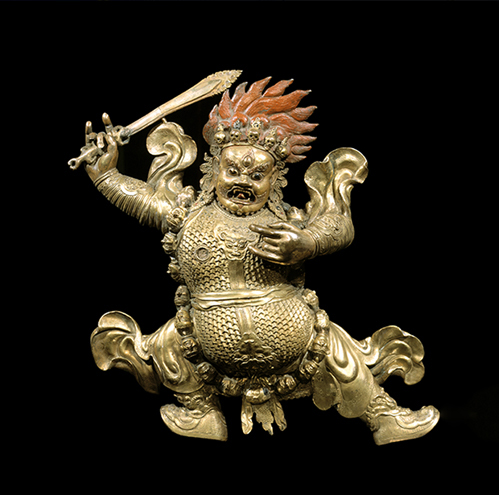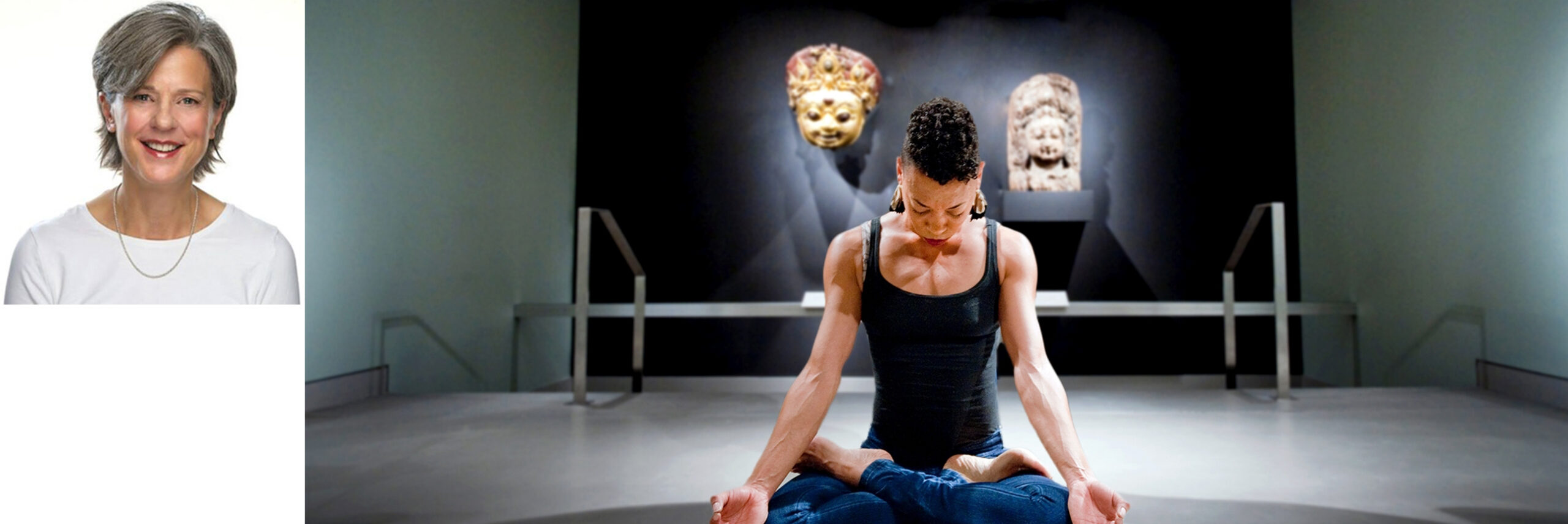
Tracy Cochran
Mindfulness Meditation
Wednesday, October 24, 2018
1:00 PM–1:45 PM Sold Out
Related Artwork

Begtse is one of the main protector figures of the Gelugpa order of Buddhism. He is distinguished by his “coat of mail,” which is wonderfully portrayed in this sculpture as it stretches over the vast expanse of his corpulent torso. He brandishes a flaming sword in his right hand and the fresh heart of the enemy in his left hand. Though these seem to be fearsome objects, they all symbolize the defeat of ego-centered conceptions. He wears the gear of the Mongolian generals with felt boots, flaring skirts and sleeves, and dragon-headed emblems on his chest, stomach, tight sleeves, and at the opening of his boots. As he is a dharmapala (protector of the faith), he also wears the elements of the wrathful deities: the five-skull crown and garland of 50 severed heads. His locks of hair fly out to one side and still bear the original red pigment, as does his curling tongue. This sculpture is a superb, large, and very rare protector example of the Zanabazar school of sculpture, which flourished in Outer Mongolia in the late 17th and first quarter of the 18th century. Zanabazar was not only a master sculptor, but an incarnate lama who was the head of the most powerful clan of the Khalka Mongols in Outer Mongolia. From around the late 16th century, Mongolia turned strongly to Tibetan Buddhism and ultimately became a stronghold of the Gelugpa order.
Theme: Hopes and Anxieties
Just in time for Halloween, this week’s meditation podcast is inspired by the gruesome, wrathful protector deity, Begtse. Tracy Cochran discusses Begtse and the Grimm’s fairy tale “Brother and Sister,” both of which offer insights into our capacity for mindful attention and love.
About the Mindfulness Meditation Podcast
The Rubin Museum of Art presents a weekly meditation session led by a prominent meditation teacher from the New York area, with each session focusing on a specific work of art. This podcast is recorded in front of a live audience, and includes an opening talk, a 20-minute sitting session, and a closing discussion. The guided meditation begins at 23:30.
If you would like to attend Mindfulness Meditation sessions in person or learn more, please visit our website at RubinMuseum.org/meditation.
This program is supported in part by the Hemera Foundation with thanks to our presenting partners Sharon Salzberg, the Interdependence Project, and Parabola Magazine.


About the Speaker

Tracy Cochran is editorial director of Parabola, a quarterly magazine that for forty years has drawn on the world’s cultural and wisdom traditions to explore the questions that all humans share. She has been a student of meditation and spiritual practices for decades and teaches mindfulness meditation and mindful writing at New York Insight Meditation Center and throughout the greater New York area. In addition to Parabola, her writing has appeared in The New York Times, Psychology Today, O Magazine, New York Magazine, the Boston Review, and many other publications and anthologies. For more information please visit tracycochran.org.
This program is now SOLD OUT.
If you would like to be added to the standby list, please review our standby procedures.
Tickets: $19.00
Member Tickets: Free (registration required)
Note: Late comers may not be admitted past 1:10 p.m., so as to not disrupt the session.

